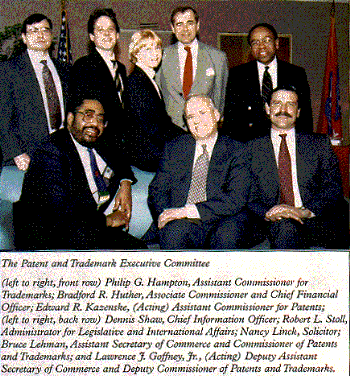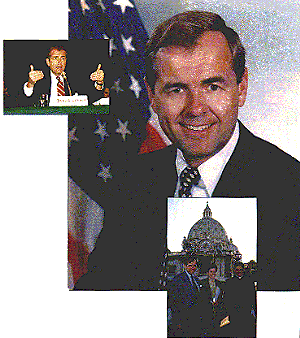Message from the Commissioner
Never before has intellectual property played a greater role in stimulating Americas economy. As budgets for government research and development have declined, patents have assumed ever-increasing importance in stimulating investment in high-technology industries and in creating jobs for millions of Americans. Trademarks, meanwhile, have facilitated business development by offering protection from unfair competition while helping consumers select products and services that satisfy their needs. Because patents and trademarks are now so inextricably linked to our national economic well-being, the ability of the Patent and Trademark Office (PTO) to conduct business efficiently and effectively is more important than ever before.
On the legislative front, we received strong bipartisan support in the 104th Congress, resulting in enactment of several bills that will enhance the protection of intellectual property. Our international negotiations and consultations continue to secure and expand protection of U.S. intellectual property throughout the world. We are working closely with other U.S. Government agencies, the private sector, and our foreign counterparts to enhance U.S. economic development on an international scale.
To achieve our goal of customer satisfaction, we need resources that will enable us to manage change by adopting cutting-edge technology and proven business concepts. Achieving this goal is being made more difficult by budget cuts. The PTO relies totally on fee revenue, not taxpayer support. to fund its operations, and much of that fee revenue is subject to the congressional appropriations process. The Omnibus Consolidated Appropriations Act withheld approximately $54 million of PTO's fee revenue from is budget for FY 1997. Since FY 1992, a total of $142 million in spending authority has been withheld from the PTO. These deep budget cuts have begun to affect PTO business operations.
Meeting our fiscal challenge will be a daunting task, but it is one all of us in the intellectual property community must resolve if Americas innovators are to receive the support and assistance they rightfully deserve from the United States Patent ad Trademark Office.

Bruce A. Lehman
Assistant Secretary of Commerce and
Commissioner of Patents and Trademarks
The Patent and Trademark Office (PTO) made significant progress in achieving its strategic goals while facing the challenges of FY 1996.
- The PTO received 191,116 utility, plant, and reissue (UPR) patent applications, and issued 105,529 UPR patents in FY 1996.
- The PTO received 22,353 provisional patent applications.
- The PTO received 200,640 trademark applications and registered 91,339 trademarks in all classes of goods and services.
- The PTO continued to strengthen its performance measurement system by redesigning its planning, budget, and evaluation process.
- Bills were introduced in Congress in 1996 proposing to convert the PTO into a performance-based, wholly owned government corporation under the policy direction of the Secretary of Commerce. The bills did not pass; they will be reintroduced in the 105th Congress.
- The PTO actively participated in international and legislative activities that influence the laws and agreements governing intellectual property rights.
- In preparation for the 21st century, the PTO continued efforts to transform patent processing, trademark processing, human resource management, and resource management into more business-like, efficient systems.
- The PTO expanded its customer outreach efforts by conducting customer focus sessions and surveys.

The mission of the Patent and Trademark Office (PTO)is to enhance industrial and technological progress in the United States by promoting the use of intellectual property rights, patents, trademarks, and copyrights as a means of achieving economic prosperity. The PTO does this by:
- administering the laws relevant to patents and trademarks;
- advising the Secretary of Commerce, the President of the United States, and the Administration on patent, trademark, and copyright protection; and
- advising the Secretary of Commerce, the President of the United States, and the Administration on the trade-related aspects of intellectual property.
Our Business
The PTO has three core business activities:
- processing patent applications;
- registering trademarks; and
- disseminating information about patents and trademarks.
At the close of FY 1996, the PTO occupied a total of 1,601,371 square feet of space in 16 buildings in Arlington, Virginia, and two storage facilities in Springfield, Virginia. The PTO also leased storage facilities in Boyers, Pennsylvania. In FY 1996, the PTO employed 5,125 full-time-equivalent (FTE) staff who:
- give inventors and entrepreneurs the protection and encouragement they need to turn their creative ideas into tangible products;
- provide innovators, businesses, and entrepreneurs protection for their inventions and trademarks;
- offer leadership in intellectual property rights policy and trade issues; and
- ensure that PTO customers receive the highest possible level of quality and customer service in all aspects of PTO operations.
Unlike most other government agencies, the PTO is funded entirely by user fees. This has been true since the passage of the Omnibus Budget Reconciliation Act of 1990. The PTO therefore has a unique responsibility to ensure that users receive efficient, cost-effective services and products that meet their needs and expectations.
PTO programs are conducted under the following principal statutory authorities:
15 U.S.C. 1051-1127 contains provisions of the Trademark Act of 1946 that govern the administration of the trademark registration system of the Patent and Trademark Office.
15 U.S.C. 1511 states that the Patent and Trademark Office is under the jurisdiction and supervision of the Department of Commerce.
35 U.S.C. contains basic authorities for administration of patent laws, derived from the Act of July 19, 1952, and subsequent enactments. Revenues from fees are available to the Commissioner to carry out, to the extent provided for in appropriations acts, the activities of the Office. The Patent and Trademark Office is authorized to charge international fees for activities undertaken pursuant to the Patent Cooperation Treaty. Deployment of automated search systems of the Office to the public is authorized.
44 U.S.C. 1337-1338 contains authority to print patents, trademarks, and other matters related to the business of the Office.
Our Strategy
Intellectual property rights are key to Americas success in the global marketplace. If U.S. businesses are to remain competitive, the effective protection of intellectual property rights must be guaranteed throughout the world.
The two main goals of the PTO are:
- to be a leader in developing intellectual property rights policy; and
- to give our customers the highest possible level of quality and services.
The PTO's Strategic Plan for 1996 through 2000 reflects the Administrations focus on the role of intellectual property in a global and technology-based economy. The Plan contains strategies for achieving the PTO's two main goals.
To achieve our first goal of playing a leadership role in intellectual property rights policy development, the PTO has established the following three strategies:
- participate in international cooperative arrangements;
- improve intellectual property systems in the United States and abroad; and
- cooperate with other government agencies to ensure that intellectual property concerns are adequately addressed.
To achieve our second goal of providing our customers with the highest possible level of quality and services, the PTO has established the following four strategies:
- enhance human resources;
- leverage information technologies;
- employ better processes; and
- manage resources effectively.
Progress toward these goals is described in the pages that follow.


